The 15 days best Luxury China Tours starts from Beijing where houses many imperial palaces like the Forbidden City, the Summer Palace, and the Temple of Heaven. It also includes Silk Road Luxury China Tours referring to the Luxury China tours with Dunhuang, Turpan, Urumqi, and Kashgar. They are the main cities on the ancient Silk Road. You may feel the charm and culture of these 5 cities by exploring Mogao Grottoes, Jiaohe Ruins, Bezikrik Thousand Buddha Caves, and Abakh Hoja Tomb. At last, the 15-day tour ends in Shanghai. You can visit the Yu Garden here and also take a stroll on Nanjing Road and the Bund. In addition, the 15 days best Luxury China Tours will provide you with a different travel experience by the boat tour in the Summer Place and the helicopter tour in the Mutianyu Great Wall. Come and join us! You will have a wonderful experience on this tour!

Today, your 15 days tour begins. Welcome to Beijing! Our guide will hold your name sign and wait for you at the airport, and then you will be transferred to the hotel. You are free to arrange your time for the rest of the day. You could have a good rest at the hotel or stroll around the hotel to get your first impression of Beijing.
Nowadays, Beijing is the capital city as well as the economic and political hub of China. In the past, it was the capital city of 6 dynasties. Thus, Beijing is home to many imperial buildings like the Forbidden City, the Summer Palace, and the Temple of Heaven. In the next few days, we will take you to visit these tourist attractions and feel the charm of imperial Beijing.
This morning, you will first visit Tian’anmen Square, which is located in the center of Beijing. With a length of about 880 meters and a width of 500 meters, it covers an area of 440,000 square meters, which is exactly equal to the size of the Vatican. It was first built in 1417 and was completed three years later. But in 1457, it was destroyed by a fire caused by lightning. Eight years later, it was rebuilt which was also destroyed later by the war. In 1651, Emperor Shunzhi, the third emperor in the Qing Dynasty (1636-1911), rebuilt it again on the remains of the building. Tian’anmen Square got a high status in the Ming (1368-1644) and Qing Dynasties. The emperors of two dynasties generally issued important edicts here. In addition, the wedding ceremony of the emperor and the empress would also be held here. Moreover, generals and soldiers sent on a battle would also hold a ceremony here before the departure. The specific process is as follows: first, the general would take the oath at the Tian’anmen Square, and then he would offer sacrifices to the gods to pray for soldiers’ safety and successful wars.
Later this morning, you will visit the Forbidden City (closed each Monday). It was the imperial palace for emperors in the Ming and Qing Dynasties. It covers an area of 720,000 square meters, which is equivalent to the area of 100 soccer fields. Walking into the Forbidden City, you will see a pair of lion sculptures in front of the Gate of Supreme Harmony. They are the largest bronze lions in existence in China. It is speculated that they were cast in the Ming Dynasty. You may find that their ears are erect as if they are on guard against intruders in the Forbidden City. The lions have different symbolic meanings. The male one which is standing on the east side with a bell hanging on its neck symbolizes supreme royal power. The female one, standing on the west side with its head slightly downward and its left foot touching a young lion, is a symbol of a bunch of sons of the imperial family. Looking up at the lions’ heads, you will find that there are a lot of spiral curls which look like knots. In ancient times, spiral curls on lion sculptures’ heads represent their owners’ social status. The more spiral curls the lion has, the higher social status its owner has. The lion in the Forbidden City has the maximum number of spiral curls and the number is forty-five. Why is forty-five? That is because, in China, the emperor was also known as Jiu Wu Zhi Zun. In Chinese characters, jiu means nine, and wu means five. Nine times five equals forty-five. Thus, there are forty-five spiral curls on the lion’s head to show the identity of the emperor.
At noon, you will eat a famous local delicacy as your lunch, that is the Peking Roast Duck. The Peking Roast Duck has a history of more than 300 years. There is a traditional way to eat it. First of all, slice the duck. The step will usually be done by the chef. Second, spread the special sauce on the thin pancake. Then, put the thin piece of the duck and some scallions on the thin pancake. If you love to eat cucumber, you could also add some to it. At last, roll the thin pancake up. Now, you could enjoy the Peaking Roast Duck.
After eating the famous Beijing delicacy, you will come to visit the Summer Palace, the largest and best-preserved imperial garden in China. It was built in the Qing Dynasty. At that time, it was a royal garden and a temporary dwelling place for emperors. While the ordinary visitors will enjoy the sightseeing on the shore, you, the visitor of the Beijing Luxury tour, will enjoy a boat tour which will provide you with a totally different experience. Along the tour, you will see many tourist attractions, like the Longevity Temple, the Tower of Buddhist Incense, and the Seventeen-Arch Bridge. Do you know why there are 17 arches? That is because emperors in ancient China liked the number 9 very much. In order to ensure that the number of arches counting from both sides of the bridge to the middle is 9, the designer put 8 arches on both sides of the large arch in the middle. Thus, the bridge has 17 arches.
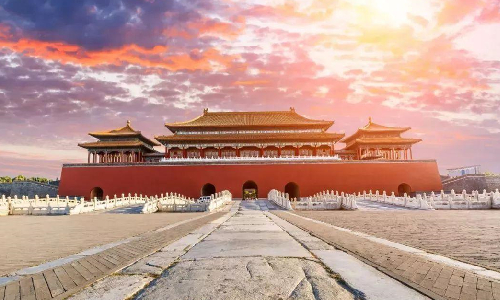
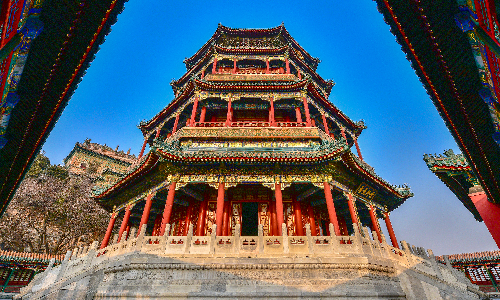
After breakfast, you will visit Hutongs, the alleyways of Beijing’s old town. It represents an important cultural element of Beijing City. The imperial palaces you visited yesterday, like the Forbidden City and the Summer Palace demonstrate the court life and elite culture of the imperial family. But Hutong represents the culture of grassroots people in Beijing. Taking a rickshaw is the most traditional and relaxing way to know about the old Beijing and feel the culture of Hutong. Along the rickshaw tour, you may see some old people playing Chinese chess or chatting with others in front of their gates. We also prepare a family visit for you. You could experience the life of local people here in a short distance. You could also ask them anything you are interested in about Hutong. For example, you could ask the history of the Hutong they are living in. Thanks to Beijing’s rich history and status as the capital city for six dynasties, almost every hutong has its own anecdotes, and some are even associated with historic events and royal families.
After lunch, you will be driven northward to the Mutianyu Great Wall, which is about 70 kilometers away from Hutong and it will take you more than 1.3 hours to get there. The Mutianyu Great Wall was generally built along an east-to-west line across the historical northern borders of China to protect the Chinese states against the raids and invasions of the various nomadic groups of the Eurasian Steppe. And it is also the longest section of the existing Great Wall. We prepare you, the visitor in our Beijing Luxury tour, a different means of transportation to visit the Mutianyu Great Wall. That is the helicopter. The helicopter tour will take you about 10 minutes and you could have a bird’s eye view of the Great Wall from high above. This is a unique experience for visitors on the luxury tour. There is no need to have any safety concerns, for we put safety first. Professional staff will conduct a security check before you take the helicopter. In addition, there are two-story VIP lounges in the take-off and landing area where you could wait for the helicopter, have a rest, and take photos. After the helicopter tour, you could also take the VIP shuttle bus, a nonstop bus to the entrance of the Mutianyu Great Wall to continue your visit. Two ways are highly recommended to get on and off the Mutianyu Great Wall. Taking a round-trip cable car is a good choice. In addition, you can also take the chairlift. Then it will be time for you to have a closer look at the Great Wall.


 Xi’an
Xi’an The only tourist attraction you will visit today is the Temple of Heaven. After breakfast, you will be transferred here. It covers an area of 2.73 million square meters, which is 4 times larger than the Forbidden City. It was first built in the Ming Dynasty and then was rebuilt by the Emperors Qianlong and Guangxu in the Qing Dynasty. Walking into the Temple of Heaven, you will see Seven Star Stones in the grassland. You may wonder why people call it Seven Star Stones while there are eight stones. Let me tell you the story behind it. When establishing the capital of the Ming Dynasty, Emperor Zhudi wanted to find a place to worship Heaven. One night, he dreamed that the gate to the Heavenly Palace was opened and the Big Dipper fell. Then, he built the Temple of Heaven in the place where the Big Dipper fell. Later, a Daoist priest said the Temple of Heaven was so empty that it would impede the Ming Dynasty’s development. Thus, Emperor Zhudi set up seven stones in accordance with the location of the Big Dipper to protect the Ming Dynasty. In the Qing Dynasty, a small stone was added in the northeast of seven stones in memory of their ancestors. Because the Qing Dynasty was founded by the people of the Manchu ethnic minority who lived in Northeast Asia. Therefore, you will see a total of 8 stones now.
After lunch, you will be transferred to the airport and take the estimated train G57 14:00/18:24 to Xi’an. The local guide will hold your name sign and wait for you at the airport. Upon your arrival, you will be driven to the hotel where you could have a good rest.

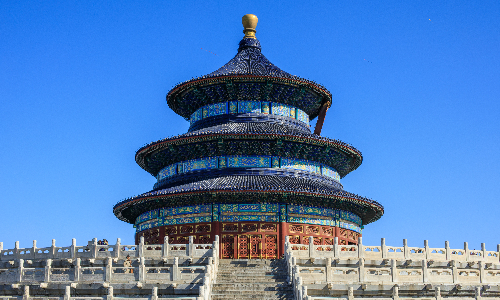
This morning, you will begin to explore Xi’an by visiting the Terra Cotta Warriors and Horses Museum. We will drive you northeast for more than 1 hour (41 KM) to get there. It is home to pottery figurines with the shape of the warrior and horse. It was built by Emperor Qin Shihuang, the first emperor of the Qin Dynasty (221-206 BC). In the Warring States period (475-221 BC), there were seven powerful states, including Qi, Chu, Yan, Han, Zhao, Wei, Qin. Qin Shihuang, also known as Ying Zheng, was born a prince of the State of Qin. When he was 13, he succeeded to the throne and became the King of the Qin. From 230 BC to 221 BC, he conquered the other six States which we mentioned above, finally unified the whole of China, and established a unified multi-ethnic country with centralization of authority. It is called the Qin Dynasty. In addition, he invented the Chinese character“皇帝” which means emperor to call himself. Therefore, he was the first emperor in the Qin Dynasty as well as in Chinese history. In his reign, he ordered to build the terra cotta warriors and horses to protect him after his death and unify the nether world. Today you will have a chance to walk into the subordinate tomb of Emperor Qin Shihuang and see the terra cotta army in person.
After lunch, you will visit the Big Wild Goose Pagoda. Built in the Tang Dynasty (618-907), it was the largest and the earliest surviving ancient building in China. The pagoda was built to preserve the scriptures that were brought from ancient India by a Buddhist monk, Tang Xuanzang. Legend has it that in his journey to ancient India to acquire Buddhist scriptures, Tang Xuanzang was marooned in the desert without any water and food. One day, two wild geese appeared and stopped in front of him. And then, they guided Tang Xuanzang to a water hole. Thanks to the water, he survived. When he returned to Xi’an, the capital city of the Tang Dynasty, he built two pagodas to express his thank to the wild geese and named them the Big Wild Goose Pagoda and the Small Wild Goose Pagoda respectively.
In the evening, you will have the Tang Dynasty Singing and Dancing Show with Dumplings Dinner. Dumpling is Chinese people’s favorable food. Eating dumplings on the lunar New Year’s Eve is an old tradition in China. It is a unique way to express Chinese people’s wishes for good luck on the occasion of ushering out the old year and ushering in the new year. You may see the shape of dumplings is like silver or gold ingot used as money in ancient times. Thus, Chinese people believe eating dumplings will bring them a wealthy life in the next year. In addition, the dumpling is made of wrappers and stuffing. Filling the stuffing in the wrapper is just like filling the good luck in your life. Therefore, it is believed that eat dumplings will bring good luck. So do not miss the dumplings banquet.
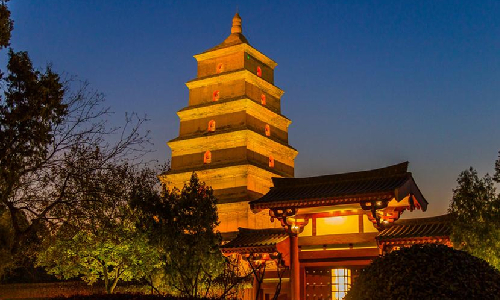
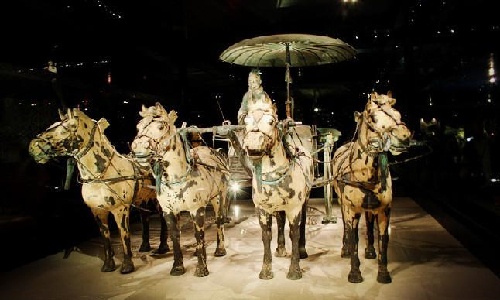
 Dunhuang
Dunhuang Today, you will be driven to the airport to take the estimated flight MU2215 12:10/14:45 to Dunhuang. The tour guide in Dunhuang will hold your name sign and wait for you at the airport. Upon your arrival, you will be transferred to the hotel where you could have a good rest.
Dunhuang, a county-level city in Gansu Province, is located at the intersection of provinces of Gansu, Qinghai, and Xinjiang. Covering an area of 31,200 square kilometers, it is equal to the area of 71 Vatican. According to China’s seventh census, the city has a population of 158,231. It is one of the oases in Gansu Province and contains Crescent Lake and Echoing-sand Dune, two famous natural landscapes. It is also a major stop on the Silk Road, an ancient network of trade routes through regions of the Asian continent, which connected the West and East from China to the Mediterranean Sea.
After breakfast, you will be driven northeast to the Mogao Grottoes, which is about 9.3 kilometers away from the downtown and it will take you about 13 minutes to get here. It was first built in the Former Qin of the Sixteen Kingdoms Period (351-395). As a large holy land of Buddhists, it now houses 735 caves, 45,000 square meters of murals, as well as 2415 painted clay figures. Most of the murals are themed with Buddhism, however, you will see a different one. There is a picture of cockfighting in the mural of No.285 Cave in Mogao Grottoes. It was created in the Western Wei Dynasty (535-557) with a history of more than 1,400 years. It is also the first picture related to roosters in Mogao Grottoes and the only cockfighting picture in 45,000 square meters of murals. Looking at the picture, you may see that two cocks are in a towering rage and staring at each other. Cockfighting is a competitive game with a long history. There were written records of cockfighting in the Spring and Autumn Period (770-476 BC). During the Three Kingdoms Period (220-265), it became very popular. In the Tang Dynasty, almost all people were keen on this game including the emperors.
After lunch, you will visit Crescent Lake, which has 100 meters in length and 25 meters in width. It is deep in the east and shallow in the west. It bends like a crescent. As a result, it is called Crescent Lake. There are many stories about its origin, and I will tell you one of them. There was a Buddhist Monk named Tang Xuanzang in the Tang Dynasty. Legend has it that in his journey to ancient India to acquire Buddhist scriptures, he got past Dunhuang, an immense desert at that time. He ran out of water and food and he was going to die. To save his life, Guanyin (a Bodhisattva) dropped a drop of water to the ground and the water became a crescent-shaped lake. Thus, the monk was saved and continued his travel to ancient India. And the lake is Crescent Lake.
After visiting Crescent Lake, you will come to see Echoing-sand Dune, which covers an area of 200 square kilometers. There is a fascinating phenomenon. If you slide down from the mountain top, you may hear the sound of thunder. There are two versions of the stories behind the thunder sound. I will tell you one of them. Legend has it that in the Han Dynasty (206 BC-220) when two armies fought here, the sand blown by the strong wind buried all the soldiers and horses. The sound of thunder is the voices of soldiers ye lling and horses neighing. Do not be afraid. In fact, it is the sound made by the friction and impact of sand and stones. You could try to slide down from the mountain top to hear the thunder sound.
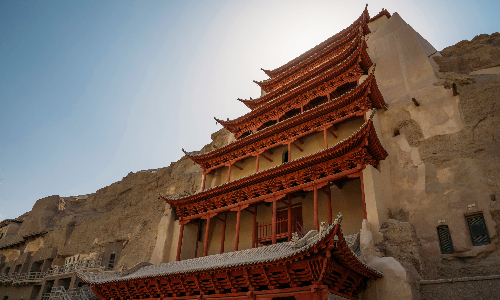
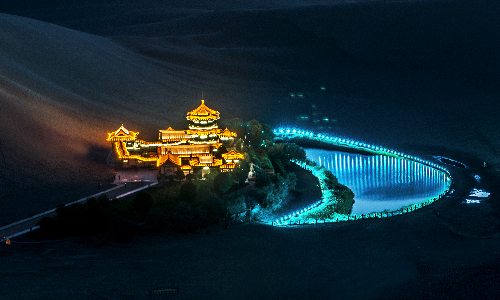
 Turpan
Turpan After breakfast, you will come to visit the Dunhuang Museum (closed each Monday). Founded in 1979, it has 129 meters in length and 100 meters in width. There are 5 exhibition halls. Exhibits on the first exhibition hall are all from the Han Dynasty. You may see a Han Dynasty writing brush, a wooden hairpin, a pair of wooden chopsticks, and a wooden panel painting with a human face here. You may marvel that chopsticks were shown up as early as 2200 years ago. As a matter of fact, people in the Shang Dynasty (1700-1045 BC) already started to use chopsticks. There are many stories behind chopsticks and I will tell you one of them. Legend has it that when Dayu (a king in ancient China) controlled the flood, he ate in the wild. When he ate meat boiled in the soup, he was eager to eat since he was pressed for time. But the soup was boiling hot and his hand could not take the meat out of the soup. Thus, he broke a tree branch and used it to take meat. It was the prototype of the chopsticks.
After lunch, you will be driven to the Liuyuannan Railway Station to take the estimated train D55 16:35/19:56 to Turpan. The local guide will hold your name sign and wait for you at the train station in Turpan. Upon your arrival, you will be transferred to the hotel where you could have a good rest.
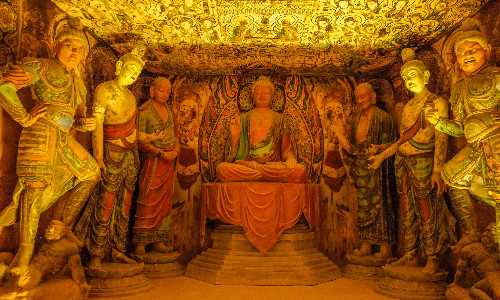

After breakfast, you will visit the Sugong Pagoda which was built in 1777 during the reign of Emperor Qianlong in the Qing Dynasty and was completed one year later. It was built to honor the exploits of the local Turpan general, Emin Khoja. Thus, it is also known as the Emin Minaret. It is a huge cone tower made of gray and yellow bricks. As the largest ancient tower in Xinjiang Province, the pagoda is 37 meters high and the diameter of the base is 10 meters. At the entrance, you will see two stone tablets with one in Uighur and the other in Chinese. Walking into the Sugong Pagoda, you will see 72 spiral steps made of brick. Other than being a ladder for people to climb to the top of the pagoda, it also functions as a pillar to support the pagoda’s body.
After visiting the Sugong Pagodas, you will come to see the Karez Well, a water-conservation facility. There is low rainfall in Turpan. Rivers formed by the snow mountain meltwater are the main water source. But they cannot meet the water demands of people in Turpan. Thus, local people used Karez Well to exploit groundwater. In Turpan, rivers soak into the ground, and groundwater is formed. In addition, there is an impermeable rock stratum under the ground of Turpan. Therefore, phreatic water is formed above the rock stratum. What the Karez Well does is to lead phreatic water to the surface by the natural slope of the mountain, with the aim to keep up with the water demands of local people’s activities.
After lunch, you will visit the Jiaohe Ruins. It was built from the second century BC to the fifth century AD. It has 1,650 meters in length and is narrow at both ends with about 300 meters in width of its widest part in the middle. Thus, it looks like a willow leaf. In 1994, archaeologists found a group of ancient tombs here. More than 200 babies under the age of two were buried inside. It is said that local people can hear the baby crying on the night of thunder and lightning. After a series of researches and analyses, scientists believe that the key reason for the baby crying sound is that the magnetic content of sand here is nine times higher than that of others. The sand, thunder, and lightning interact with each other and function like a tape recorder. In ancient times, the sand, thunder, and lightning recorded the sound of the baby crying in the Jiaohe City. And then, at the same condition, the sound will be released even thousands of years later. Thus, local people can hear the baby crying on the night of thunder and lightning.

 Urumqi
Urumqi After breakfast, you will come to visit the Bezikrik Thousand Buddha Caves. First chiseled in the Northern and Southern Dynasties (420-859), it covers an area of 1,200 square meters. It is a complex of Buddhist cave grottoes with the largest number of caves in the existing grottoes in Turpan. There were 83 caves originally. But now, it is home to 57 caves and among them more than 40 caves have murals. Rounded arch ceilings of most caves are divided into four sections, each with a mural of the Buddha. On some murals, you may see a large Buddha surrounded by other people, including Indians, Turks, and Europeans.
After lunch, you will be driven to the train station and take the estimated train D8805 14:32/15:27 to Urumqi. The local guide will hold your name sign and wait for you at the train station of Urumqi. Upon your arrival, you will be transferred to the hotel where you could have a good rest.
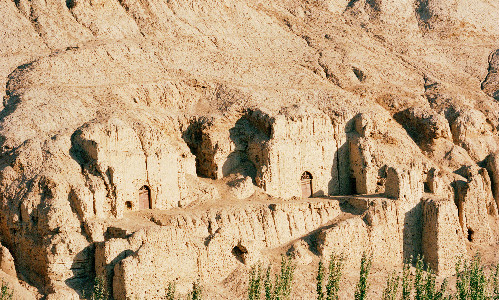

 Kashgar
Kashgar Today, you will come to visit the Xinjiang International Grand Bazaar. It was founded on 26 June 2003. Covering an area of 39,888 square meters, it is the largest of its kind in the world. There is a food court covering an area of 3,225 square meters and gathering classic delicacies in 56 ethnic groups in China. Of course, there are also local delicacies like Roast Whole Lamb. It is the noblest way of eating lamb. In ancient times, Roast Whole Lamb was only available to dignitaries, and ordinary people could not enjoy it. But now, it has become a common meal in Xinjiang people’s daily life. You could have a try. In addition, you should learn the word “posh” in advance. This is the local dialect that means “excuse me” in Uighur. You may need it, for there are many sellers and visitors and sometimes it is a little bit crowded.
In the afternoon, you will be transferred to the airport and take the estimated flight CZ6998 15:30/17:25 to Kashgar. The local guide will hold your name sign and wait for you at the airport. When you arrive, you will be driven to the hotel. You can have a good rest or walk around the hotel.
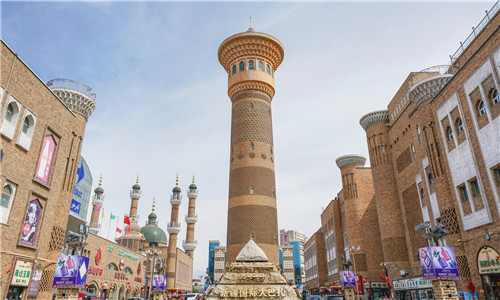

This morning, you will visit the Abakh Hoja Tomb after breakfast. It is a gorgeous building that has 40 meters in length and covers an area of about 20,000 square meters. It is a typical Islamic ancient complex. It is said that 72 people for 5 generations of the Hoja family were buried in the tomb. But nowadays, you can just see 58 tombs. A woman named Ipar Khan was buried here. She was a favorable imperial concubine of Emperor Qianlong, the sixth emperor of the Qing Dynasty. Legend has it that she was born with a nice scent and smelled like a flower. Thus, she was called Xiangfei. “Xiang” means fragrance and “Fei” means imperial concubine. When she died, she was sent back to Kashgar and buried in the Abakh Hoja Tomb. Therefore, the Abakh Hoja Tomb was also known as the Xiangfei Tomb.
Next, you will visit the Id Kah Mosque. It was first founded in 1442. As the largest mosque in Xinjiang Province, it is 140 meters long from north to south and 120 meters wide from east to west, covering a total area of 16,800 square meters. There is a big square in front of Id Kah Mosque. More than 2,000 people gather here to worship every day. At the annual Eid al-Adha or Sacrifice Feast (an important festival for Muslims), believers from all over the world will gather here and attend the celebration. After that, drum music will be played and costumed people will do Sama dance and sway to the drum music. Sama was one of the prehistoric religions. In ancient times, Uygur ethnic group once followed this religion. At that time, local people were lack of food, they would do Sama dance to pray for a good harvest in hunting and agriculture. As China has boomed, Uighurs are not struggling for food any longer. But Sama dance was taught from generation to generation as a way of relaxing and celebrating. If you are lucky, you may see the Sama dance. And maybe you could even learn some steps from them.
After lunch, you will come to see the Kashgar Old Town. It covers an area of 8.36 square kilometers. It is home to 220,000 people, almost half of the total population of Kashgar. Located in the downtown area of Kashgar, it is the only traditional historical district featuring the Western Regions in China. Local people are known for their hospitality. Tourists are allowed to visit their residences. There is an interesting and unique custom. If the two doors of the residence are open, that means the male owner is at home. If you only see a single door open, the hostess is at home. And if you see a curtain hanging in front of the door, guests are visiting the residence. In addition, if you like taking photos, you should wear colorful clothes with a high degree of saturation. Because most walls here are yellow, the colorful clothes with a high degree of saturation will make you more prominent. Of course, when taking photos, you should keep in mind that do not disrupt local people’s life.


 Shanghai
Shanghai Today, you will come to visit the Kashgar Big Bazaar. As the largest market in Kashgar, it covers an area of about 0.17 square kilometers. There are more than 4,000 stalls that sell more than 9,000 kinds of commodities. Apart from the local products, you can also see foreign goods, especially the goods made in Central Asian countries. Because Kashgar has a long history of trading with these countries. China shares its borders with Kyrgyzstan, Tajikistan, Afghanistan, and Pakistan in Kashgar, which provides favorable conditions for bilateral trading. You may see handicraft products from Pakistan, silk scarfs from Turkey, as well as dried fruit from Saudi Arabia. At the same time, they are sold at a lower price. It is a good choice to buy some of them to give your families and friends as presents.
Then, you will be transferred to the airport to take the estimated flight CZ6997 14:30/22:00 to Shanghai, a cosmopolitan city in China. The local guide will hold your name sign and wait for you at the airport. When you arrive, you will be driven to the hotel. You can have a good rest or walk around the hotel.


After breakfast, you will come to see the Yu Garden (closed each Monday). Built in the Ming Dynasty, it was a private garden and was not opened to the public until 1961. Walking into the Yu Garden, you will see many tourist attractions like Huge Rockery, Huijing Tower, and Exquisite Jade Rock. The Exquisite Jade Rock is not a real jade but a Taihu stone. The stone has about 1.5 meters in width and 3 meters in length. It weighs approximately 3 tons. It is eroded by water. The biggest feature of this stone is that there are as many as 72 holes. At first glance, you might think you see a huge honeycomb. If you pour water from top to bottom, it will look like a waterfall with 72 holes flowing water; if you burn incense under the stone, the smoke will billow from these holes, which is enchanting scenery.
Then, you will visit the Jade Buddha Temple, which is 7.5 kilometers away from the Yu Garden. Built in the Qing Dynasty, it has a history of more than 100 years. It is home to the Reclining Buddha Hall with two reclining Buddhas inside. The larger one was from Singapore. It is carved from a whole piece of jade with extreme care and precision. It is 4.05 meters in length and 6 tons in weight. The Buddha is wearing a Kasaya (a traditional robe of Buddhist monks). It is lying on the right side with the left hand placing on the left thigh and the right hand supporting the head. With a kindly face, it seems that it has reached the state of nirvana (the state of peace and happiness after giving up all desires in Buddhism).
At noon, you will taste the dim sum of Shanghai: Guantang bao also named soup-filled buns. The local way to eat is to have a small bite of the wrapper of Guantang bao and then sip the soup in the bun. At last, you can eat the wrapper and the stuffing together. You should pay attention to the temperature of the soup inside when you start eating. Be careful not to scald yourself.
After eating Guantang bao, you will come to visit the Shanghai Tower. When visiting Shanghai, ordinary tourists will visit the Oriental Pearl TV Tower, one of the world’s tallest TV towers. But you, a visitor on our Shanghai Luxury tour, will visit the Shanghai Tower, which is taller than the Oriental Pearl TV Tower. With a total height of 632 meters, it is known as the tallest building in China as well as the second tallest one in the world. There are 127 floors on the ground and 5 floors under the ground. The Top of Shanghai Observatory, where you can have a comprehensive view of Shanghai, is on the one hundred and eighteenth floor. Do not be afraid of its high floor. Because Shanghai Tower is equipped with the world’s fastest elevator. It will take you just 55 seconds to get there.
Next, you will come to see the Nanjing Road, the first commercial street after Shanghai opened up its port for trade. If you are a foodie lover, you can never miss the delicacies in lots of century-old shops there. Take Shen Dacheng Pastry as an example. Founded in the Qing Dynasty, it has a history of more than 140 years. Qingtuan, or Sweet Green Rice Ball, is a famous delicacy in Shen Dacheng Pastry, attracting lots of visitors in China and beyond. It is made of glutinous rice mixed with Chinese mugwort or barley grass. It is very chewy. There is different stuffing in Qingtuan. If you are a sweet lover, you could try the Qingtuan stuffed with bean paste. If you like salty food, you could try the Qingtuan stuffed with salted egg yolk. Of course, there is other stuffing not mentioned yet, which is waiting for you to explore.
At last, you can take a stroll on the Bund. The Bund, also called Waitan, is a world-famous waterfront promenade on the west bank of the Huangpu River. It has 1.5 kilometers in length. To the west of the stretch stand 52 buildings of different architectural styles, including Baroque, Gothic, and Neoclassical styles. So, it has also known as the museum of buildings as well as the exotic building clusters in Shanghai. These buildings have become one of the must-see tourist attractions in Shanghai. The best way to appreciate them is to have a walk along the Bund. While you are walking, you can also take a photo that may enable you to receive more followers on Instagram or other social media.
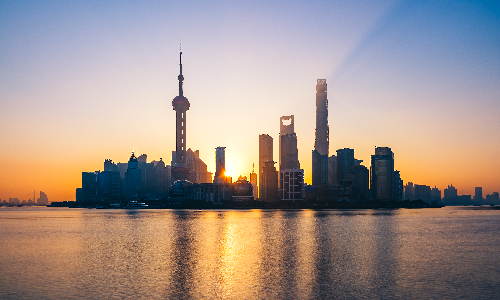

Today, our 15 days tour comes to an end. Your tour guide will escort you to the airport. We sincerely hope that you have a pleasant journey in these 15 days. If you want to visit China again, China Tour Star will be delighted to serve you again. Have a nice trip!
Author: Cao Junyan
Proofreader: Betsy He
| City | Five Star hotel list | Four Star hotel list |
|---|---|---|
| Beijing | Sunworld Dynasty Hotel Beijing Wangfujing | Sunworld Hotel Wangfujing |
| Xi'an | Tianyu Gloria Grand Hotel Xi'an | Sunworld Dynasty Hotel |
| Dunhuang | Wan Sheng International Hotel | Grand Sun Hotel Dunhuang |
| Turpan | Jinjiang Metropolo Hotel - Turpan Administration Center | Mercure Hotel Turpan Downtown |
| Urumqi | Grand Mercure Urumqi Hualing | Tumaris Hotel |
| Kashgar | Yue Xing Jin Jiang International Hotel | Tianyuan International Hotel |
| Shanghai | Ocean Hotel Shanghai | Courtyard by Marriott Shanghai Central |
 |
![]() About your child or infant, please contact us for a discounted price.
About your child or infant, please contact us for a discounted price.



We started with a few days in Beijing & ended in Shanghai, from where we visited the Forbidden City and Great Wall. In between we visited Terra Cotta Warriors Museum, Panda Base, Shanghai Disneyland.

We had a wonderful holiday in China which will remain long in the memory. China is a breathtakingly beautiful country full of splendid temples and palaces, mountains and rivers, peaceful rural scenes and bustling shopping streets.
 QUICK ENQUIRY
QUICK ENQUIRY